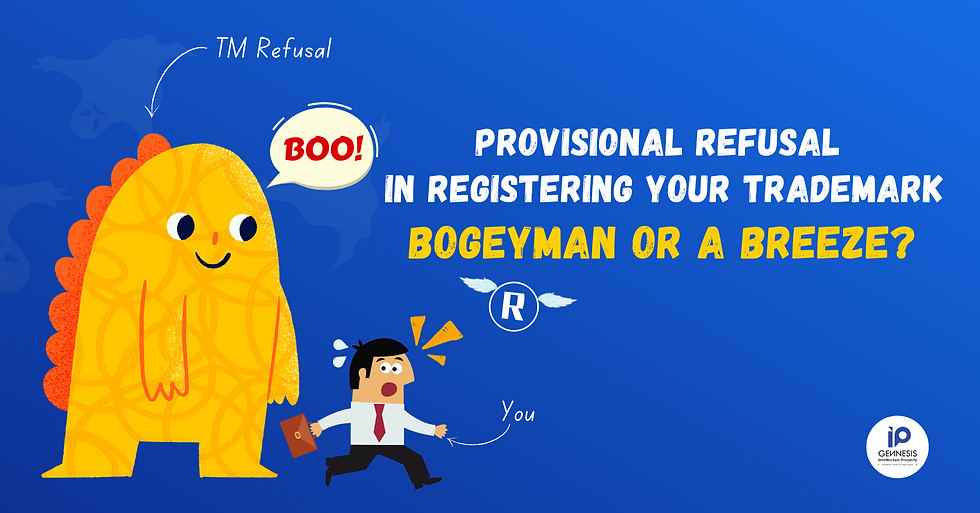Provisional Refusal in Registering Your Trademark-Bogeyman or A Breeze?
- IP Gennesis

- Jun 16, 2022
- 3 min read
We’re back with another installation in our trademarks series – this time with some thoughts on refusal by the Registrar as part of the trademark registration process.
The idea of being denied a trademark registration, even provisionally, must seem scary. We’re here to tell you that a refusal letter from MyIPO doesn’t have to be business owners’ trademark bogeyman.
As always, heavy reference will be made to our trademarks bible – the Trademarks Act (TMA) 2019.
At this stage, when we talk about receiving a refusal letter, we specifically mean a provisional refusal letter. There are two parts of this process that are relevant to a provisional refusal: formality validation and substantive examination. There is merit in drawing a distinction between the two.

Formality Examination
During the formality validation, the Registrar is only looking at anything related to formality. He will check if you have supplied all the information and documents that are required. The Registrar will not be looking at the trademark itself at this stage. The Registrar will make your life a little easier by pointing out in his letter exactly what formality requirement has not been met. You will be asked to amend your application accordingly, should you wish to go ahead with the application. As the Applicant, you will usually be given 2 months from the date of the letter to respond. If there is no response within that time frame the matter will be considered abandoned, otherwise it will proceed according to the Registrar’s direction.
Substantive Examination
A substantive examination is where the Registrar will look at your trademark itself. It is done specifically for the purpose of checking the registrability of the trademark under the requirements of the Trademarks Act 2019. Most of the time the provisional refusals are raised on absolute and relative grounds of refusal, although the Registrar is not prohibited from refusing a trademark application based on other provisions of the TMA.
At risk of providing an oversimplification, absolute grounds of refusal as laid down by Section 23 of the TMA tend to involve the nature and representation of the trademark itself. Take the word “Apple” as an example, an apple seller cannot register the word “apple” as his trademark because that describes the product itself, i.e. apples. However, an electronics company has no trouble registering the word “Apple” as a trademark for the purpose of selling mobile phones. This is because Section 23(1)(c) of TMA provides that a trademark will be refused registration if it is a sign which may serve in trade to designate the kind, quality, intended purposes and other characteristics of the product, being phones.
On the other hand, if a trademark is found to be confusingly similar with an earlier mark, it will be refused under Section 24 of the TMA, which provides for relative grounds of refusal.
The provisional refusal letter will lay out the detailed grounds upon which the Registrar has made his or her decision to provisionally refuse the trademark application. This should give you an idea of which provision(s) of the TMA your trademark application does not comply with.
What's The Next Step?
Following a provisional refusal of this nature, you will be given the opportunity to make an appeal by representation, amend the application or provide additional information. The applicant can make a representation by submitting a written appeal only, or by requesting for an appeal by hearing.
The written appeal involves filing a written submission as well as a statutory declaration showing evidence of use in response to the refusal. In the case of an appeal hearing, also known as an ex-parte hearing, your trademark agent may appear on your behalf before the Registrar to submit an appeal verbally, as well as file the written submission and statutory declaration in support of the appeal.
Following an appeal, the Registrar will go through your application once more with a fine-tooth comb. The chances of a successful appeal vary depending on the grounds that the Applicant’s Mark was rejected on, and the evidence that the Applicant can provide in favour of registering the Mark.
Should the Registrar refuse your application after the appeal, it is still not the end. You could appeal to the court against the Registrar’s decision.
The appeal process should not be taken lightly because you may only have one opportunity to appeal before the Registrar. Hence, it is highly advisable to appoint a competent trademark agent to manage your trademark registration process. Please feel free to contact us for further enquiries!
Written by,
Registered Trademark, Patent and Design Agent
LL.B (HONS), CLP
Advocate & Solicitor (Non-Practising)
IP Legal Intern
LL.B (HONS)
Disclaimer: The above information is merely for general sharing and does not constitute any legal advice. Readers are advised to seek individual advice from professionals.
© 2022 by IP Gennesis Sdn Bhd.







Comentarios